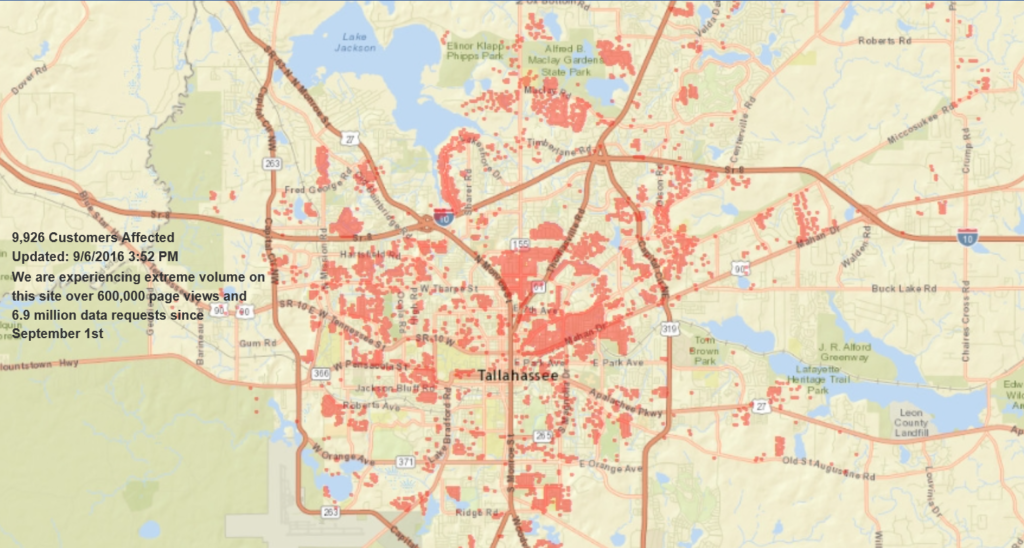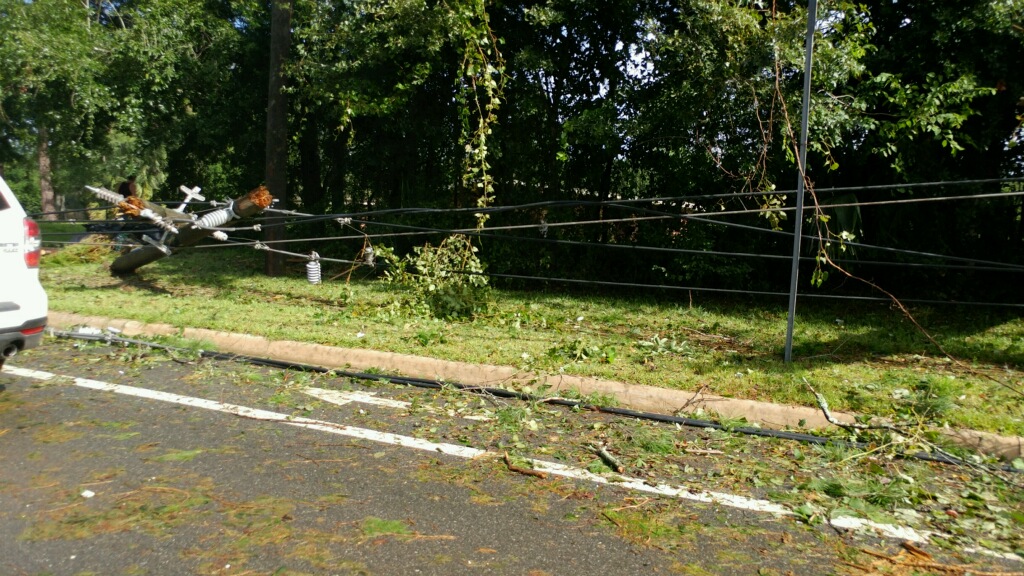The Situation
Hurricane Hermine started making her impression on Tallahassee in the evening of Thursday, September 1, 2016. Only a few hours into the storm, approximately 130,000 in the Tallahassee region lost power, including almost 70,000 customers of the City of Tallahassee public utility. As of 4:30pm on Tuesday, September 6, 10,000 of those same customers are still without power; see the power outage map below from the City of Tallahassee. Five days after the storm, over 4,000 people continue without power.

These customers included hospitals, fire departments, detention facilities, schools, homes, and businesses across the area. And no power means no water and no bathrooms for those customers not using the utility-provided water, since wells and pumps require power to function.
Two power sub-stations went down, apparently due to major equipment failure.
Also, since Tallahassee is known for its beautiful live oaks and mature trees, the vulnerability of the above-ground power lines was exploited.
The good, bad, and ugly of risk management decision-making…and how it impacts people
The good – The City of Tallahassee Utilities and State of Florida have mutual aid agreements with utility companies in surrounding areas and states to provide manpower and equipment when needed to restore power. These agreements were good strategic risk management decisions to support their customers and protect their reputation; in other words, the agreements mitigated reputation risk for the City of Tallahassee. Those utility crews have been working diligently to restore power, often working 16 hour shifts to cut trees, replace power poles and lines, and restore power as quickly and safely as possible. Those agreements have been a life-saver to those without power!
Another good – Publix Supermarkets has 10 stores in Tallahassee, and all of them were open early Friday morning, running on generators. People breathed a huge sigh of relief when they saw the stores lit up, knowing they could enjoy a little coolness in the air conditioning, socialize with people, and buy groceries to feed their families. Publix is a Florida-based company, so the owners are well-aware that to do business in Florida means needing generators if you want to open the doors for your customers and keep the revenue flowing in the doors. Having generators at each of the stores protected, and likely enhanced, Publix’s reputation in the Tallahassee area.
The bad – A decision by Walmart to not have a generator at one of their “upscale” stores in Tallahassee resulted in the store having to discard all of its perishable food inventory (meat, poultry, dairy, eggs, raw produce). This large scale disposal meant the store, normally open 24 hours, closed for 8 hours overnight on Saturday to handle this health issue.
the store having to discard all of its perishable food inventory (meat, poultry, dairy, eggs, raw produce). This large scale disposal meant the store, normally open 24 hours, closed for 8 hours overnight on Saturday to handle this health issue.
So a simple decision about a generator – accepting reputation risk, financial risk, and market risk – caused a supercenter to lose both inventory and sales revenue, while people had to find other sources for food and necessary items.
In fact, those people most likely went to Publix (see above paragraph). In Florida, known for hurricanes, it is always a better decision for a large business to buy a generator to mitigate the financial risks.
The ugly – The loss of power also impacted cell phone reception in certain areas, as thirteen AT&T towers lost power. Coupled with people frantically contacting friends and families and using their phones to stay updated on news and weather, the available bandwidth for people near the impacted phone towers were doubly-hit.
I know…I was one of those people who could not call, text, or email from my house…
In order to provide updates to people, I had to drive up the street to get one to two bars on the phone to text or call; even then, calls would sometimes drop suddenly. Therefore, I would say that AT&T’s decision not to have a back-up plan for power supply to their towers was an ugly risk management decision. As typical in these circumstances, people took to Facebook and Twitter to voice their frustrations with AT&T, while others praised Verizon’s continuous service during and after the storm.
In addition to the financial consequence of buying generators at a premium price, AT&T also flirted with reputation risk and potential market share risk. Buying the generators in advance of the storm and having sufficient time to test their functionality would have been the best risk mitigation strategy for AT&T in this circumstance.
As we can see from this particular situation, risk management decisions can either be a positive or negative during a particular crisis. We hope everyone affected by the storm can learn from this situation and apply those lessons to future storms or other emergencies.
To learn more, check out our article 6 Steps to Setting up your Business Continuity Program today!
We invite you to continue browsing our risk management resource to learn more about how businesses and organizations can protect value, or click here to learn more about my risk management background and how I can help identify and manage risks to your organization.








